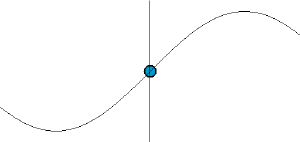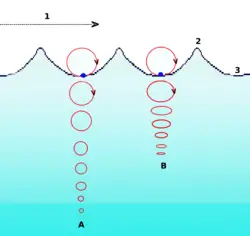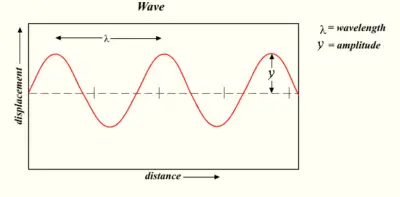Difference between revisions of "Wave" - New World Encyclopedia
(→See also: editing) |
|||
| Line 58: | Line 58: | ||
== Mathematical description == | == Mathematical description == | ||
[[Image:wave.png|right|400px]] | [[Image:wave.png|right|400px]] | ||
| − | |||
| − | + | Waves can be described mathematically using a series of parameters, including its amplitude, wavelength, wavenumber, period, and frequency. | |
| − | The ''' | + | The '''amplitude''' of a wave (commonly denoted as ''A'' or another letter) is a measure of the maximum disturbance in the medium during one wave cycle. In the illustration to the right, this is the maximum vertical distance between the baseline and the wave. The units for measuring amplitude depend on the type of wave. Waves on a string have an amplitude expressed in terms of distance (meters); sound waves, as pressure (in pascals); and electromagnetic waves, as the amplitude of the [[electric field]]* (in volts/meter). The amplitude may be constant, in which case the wave is called a ''continuous wave'' (c.w.), or it may vary with time or position. The form of variation of amplitude is called the ''envelope'' of the wave. |
| − | A ''' | + | The '''wavelength''' (denoted as <math>\lambda</math>) is the distance between two successive crests (or troughs). It is generally measured on the metric scale (in meters, centimeters, and so on). For the optical part of the electromagnetic spectrum, wavelength is commonly measured in nanometers (1 nanometer = a billionth of a meter). |
| + | |||
| + | A '''wavenumber''' <math>k</math> can be associated with the wavelength by the relation | ||
:<math>k = \frac{2 \pi}{\lambda}</math>. | :<math>k = \frac{2 \pi}{\lambda}</math>. | ||
| − | The ''' | + | The '''period''' <math>T</math> of a wave is the time taken for a wave oscillation to go through one complete cycle (one crest and one trough). The '''frequency''' <math>f</math> (also denoted as <math>\nu</math>) is the number of periods per unit time. Frequency is usually measured in [[hertz]]* (Hz), which corresponds to the number of cycles per second. The frequency and period of a wave are reciprocals of each other. Thus their mathematical relationship is: |
:<math>f=\frac{1}{T}</math>. | :<math>f=\frac{1}{T}</math>. | ||
| − | |||
The ''[[angular frequency]]'' <math>\omega</math> represents the frequency in terms of radians per second. It is related to the frequency by: | The ''[[angular frequency]]'' <math>\omega</math> represents the frequency in terms of radians per second. It is related to the frequency by: | ||
| Line 106: | Line 106: | ||
:<math>v=\sqrt{\frac{T}{\rho}}.</math> | :<math>v=\sqrt{\frac{T}{\rho}}.</math> | ||
| − | |||
| − | |||
==See also== | ==See also== | ||
Revision as of 14:43, 2 August 2006
- This article is about waves in the most general scientific sense; a separate article focuses on ocean waves.
- For other meanings see wave (disambiguation).
A wave is a disturbance that propagates through space, often transferring energy. Examples include ocean waves such as the wake generated by a passing ship; sound waves, which travel rapidly through the air from their source, and vibrational disturbances through solid media such as the earth. While a mechanical wave propagates through a medium, waves of electromagnetic radiation (and perhpas gravitational radiation) can travel through a vacuum, that is, without a medium. Waves travel and transfer energy from one point to another, with little or no permanent displacement of the particles of the medium. In other words, there is little or no associated transport of mass, but there are oscillations around fixed positions.
- [a mechanical wave propagates through a medium, which on deformation is capable of producing elastic restoring forces, similar to the way a rubber band snaps back after it is extended]
Examples
Examples of waves include:
- Ocean surface waves, which are perturbations that propagate through water.
- Sound waves, which are mechanical waves that propagate through air, liquids, or solids. In common usage, sound waves have frequencies that are detectable by the human ear. Scientists, however, include other similar vibratory phenomena in the general category of "sound," even when they lie outside the range of human hearing. Seismic waves, detectable during earthquakes, lie in this category.
- Electromagnetic radiation, which is constituted of radio waves (including microwaves), infrared rays, visible light, ultraviolet rays, X rays, and gamma rays. In this case, the waves can propagate through a vacuum (that is, without a medium). Electromagnetic waves travel at a speed of 299,792,458 meters/second in a vacuum.
- Gravitational waves, which are fluctuations in the gravitational field predicted by Einstein's theory of General Relativity. These waves are nonlinear and have yet to be observed empirically.
Characteristics
Periodic waves are characterized by crests (highs) and troughs (lows). If the waves remain in one place, such as the vibrations of a violin string, they are called standing waves. If the waves are moving, they are called traveling waves.
Waves are often categorized as either longitudinal or transverse. Transverse waves are those with vibrations perpendicular to the direction of propagation of the wave; examples include waves on a string and electromagnetic waves. Longitudinal waves are those with vibrations parallel to the direction of propagation of the wave. Most sound waves are longitudinal waves, where the air is both compressed and rarified in the direction of movement of the traveling wave.
Ripples on the surface of a pond are actually a combination of transverse and longitudinal waves, and the points on the surface follow orbital paths. Thus, when an object bobs up and down on ripples in a pond, it experiences an orbital trajectory.
All waves have common behavior under a number of standard situations, as follows:
- Reflection – the change of direction of waves when they hit a reflective surface.
- Refraction – the change of direction of waves when they enter a new medium.
- Diffraction – the circular spreading of waves that happens when the distance between waves move through an opening of equal distance.
- Interference – the superposition of two waves that come into contact with each other.
- Dispersion – the splitting up of waves according to their frequency.
- Rectilinear propagation – the movement of waves in straight lines.
Polarization
A wave is said to be "polarized" when it oscillates in only one direction. The polarization of a transverse wave (such as light) indicates that the oscillations occur in a single plane perpendicular to the direction of travel. Longitudinal waves, such as sound waves, do not exhibit polarization, because for these waves the direction of oscillation is along the direction of travel. A wave can be polarized by using a device called a "polarizing filter."
Transmission medium
The medium that carries a wave is called the transmission medium. It can be classified into one or more of the following categories:
- A linear medium, if the amplitudes of different waves at any particular point in the medium can be added.
- A bounded medium, if the medium is finite in extent; otherwise, the medium is called an unbounded medium.
- A uniform medium, if the physical properties of the medium are the same in different parts of the medium.
- An isotropic medium, if the physical properties of the medium are the same in different directions.
Mathematical description
Waves can be described mathematically using a series of parameters, including its amplitude, wavelength, wavenumber, period, and frequency.
The amplitude of a wave (commonly denoted as A or another letter) is a measure of the maximum disturbance in the medium during one wave cycle. In the illustration to the right, this is the maximum vertical distance between the baseline and the wave. The units for measuring amplitude depend on the type of wave. Waves on a string have an amplitude expressed in terms of distance (meters); sound waves, as pressure (in pascals); and electromagnetic waves, as the amplitude of the electric field (in volts/meter). The amplitude may be constant, in which case the wave is called a continuous wave (c.w.), or it may vary with time or position. The form of variation of amplitude is called the envelope of the wave.
The wavelength (denoted as ) is the distance between two successive crests (or troughs). It is generally measured on the metric scale (in meters, centimeters, and so on). For the optical part of the electromagnetic spectrum, wavelength is commonly measured in nanometers (1 nanometer = a billionth of a meter).
A wavenumber can be associated with the wavelength by the relation
- .
The period of a wave is the time taken for a wave oscillation to go through one complete cycle (one crest and one trough). The frequency (also denoted as ) is the number of periods per unit time. Frequency is usually measured in hertz (Hz), which corresponds to the number of cycles per second. The frequency and period of a wave are reciprocals of each other. Thus their mathematical relationship is:
- .
The angular frequency represents the frequency in terms of radians per second. It is related to the frequency by:
- .
There are two velocities that are associated with waves. The first is the phase velocity, which gives the rate at which the wave propagates, is given by
- .
The second is the group velocity, which gives the velocity at which variations in the shape of the wave's amplitude propagate through space. This is the rate at which information can be transmitted by the wave. It is given by
The wave equation
The wave equation is a differential equation that describes the evolution of a harmonic wave over time. The equation has slightly different forms depending on how the wave is transmitted, and the medium it is traveling through. Considering a one-dimensional wave that is travelling down a rope along the -axis with velocity and amplitude (which generally depends on both x and t), the wave equation is
In three dimensions, this becomes
- .
It should be noted that the velocity will depend on both the type of wave and the medium through which it is being transmitted.
A general solution for the wave equation in one dimension was given by French physicist-mathematician Jean Le Rond d'Alembert (1717-1783). It is
This can be viewed as two pulses travelling down a taut rope in opposite directions; F in the +x direction, and G in the -x direction. If we substitute for x above, replacing it with directions x, y, z, we then can describe a wave propagating in three dimensions.
The Schrödinger equation describes the wave-like behaviour of particles in quantum mechanics. Solutions of this equation are wave functions which can be used to describe the probability density of a particle. Quantum mechanics also describes particle properties that other waves, such as light and sound, have on the atomic scale and below.
Traveling waves
Traveling waves have a disturbance that varies with both time and distance . This can be expressed mathematically as:
where is the amplitude envelope of the wave, is the wave number and is the phase. The phase velocity of this wave is given by:
where is the wavelength of the wave.
Propagation through strings
The speed (v) of a wave traveling along a string is directly proportional to the square root of the tension (T) over the linear density (ρ):
See also
Further reading
- French, A.P. (1971). Vibrations and Waves (M.I.T. Introductory physics series). Nelson Thornes. ISBN 074874479.
External links
- Science Aid: Wave properties Concise guide aimed at teens
- Vibrations and Waves - an online textbook
- A Radically Modern Approach to Introductory Physics - an online physics textbook that starts with waves rather than mechanics
- Sounds Amazing - AS and A-Level learning resource for sound and waves
Credits
New World Encyclopedia writers and editors rewrote and completed the Wikipedia article in accordance with New World Encyclopedia standards. This article abides by terms of the Creative Commons CC-by-sa 3.0 License (CC-by-sa), which may be used and disseminated with proper attribution. Credit is due under the terms of this license that can reference both the New World Encyclopedia contributors and the selfless volunteer contributors of the Wikimedia Foundation. To cite this article click here for a list of acceptable citing formats.The history of earlier contributions by wikipedians is accessible to researchers here:
The history of this article since it was imported to New World Encyclopedia:
Note: Some restrictions may apply to use of individual images which are separately licensed.





























